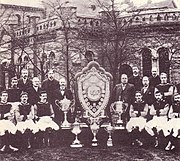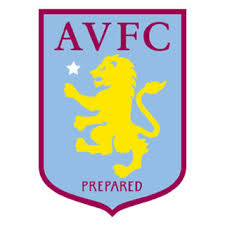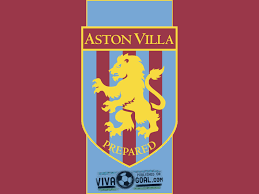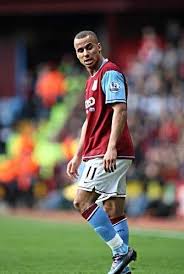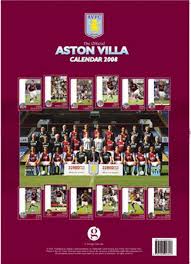England
The League Cup, or called Carling Cup
Portsmouth FC vs Aston Villa
Match scheduled:
Date: 01-12-2009
Time::45 until 21:45
Round 5 - Quarter Finals :: Carling Cup / English League Cup 2009/2010 :: Small chance but might show up!
Aston Villa Football Club were formed in March, 1874, by members of the Villa Cross Wesleyan Chapel in Handsworth which is now part of Birmingham. The four founders of Aston Villa were Jack Hughes, Frederick Matthews, Walter Price and William Scattergood. [10] Aston Villa's first match was against the local Aston Brook St Mary's Rugby team. As a condition of the match, the Villa side had to agree to play the first half under rugby rules and the second half under football rules.[11] Villa soon established themselves as one of the best teams in the Midlands, winning their first honour, the Birmingham Senior Cup in 1880, under the captaincy of Scotsman George Ramsay.[12]
The club won its first FA Cup in 1887 with captain Archie Hunter, becoming one of the game's first household names. Aston Villa were one of the dozen teams that competed in the inaugural Football League in 1888 with one of the club's directors, William McGregor being the league's founder. Aston Villa emerged as the most successful English club of the Victorian era, winning no fewer than five League titles and three FA Cups by the end of Queen Victoria's reign.[13] In 1897, the year Villa won The Double, they moved into their present home, the Aston Lower Grounds.[14] Supporters coined the name "Villa Park"; no official declaration listed the ground as Villa Park.[15]
Aston Villa won their sixth FA Cup in 1920, soon after though the club began a slow decline that led to Villa, at the time one of the most famous and successful clubs in world football, being relegated in 1936 for the first time to the Second Division. This was largely the result of a dismal defensive record: they conceded 110 goals in 42 games, 7 of them coming from Arsenal's Ted Drake in an infamous 1–7 defeat at Villa Park.[16] Like all English clubs, Villa lost seven seasons to the Second World War, and that conflict brought several careers to a premature end.[17] The team was rebuilt under the guidance of former player Alex Massie for the remainder of the 1940s. Aston Villa's first trophy for 37 years came in the 1956–57 season when another former Villa player, Eric Houghton led the club to a then record seventh FA Cup Final win, defeating the 'Busby Babes' of Manchester United in the final.[18] The team struggled in the league though and were relegated two seasons later, due in large part to complacency. However, under the stewardship of manager Joe Mercer Villa returned to the top-flight in 1960 as Second Division Champions. The following season Aston Villa became the first team to win the Football League Cup.[19]
Mercer's forced retirement from the club in 1964 signaled a period of deep turmoil. The most successful club in England was struggling to keep pace with changes in the modern game, with Villa being relegated for the third time, under manager Dick Taylor in 1967. The following season the fans called for the board to resign as Villa finished 16th in the Second Division. With mounting debts and Villa lying at the bottom of Division Two, the board sacked Cummings (the manager brought in to replace Taylor), and within weeks the entire board resigned under overwhelming pressure from fans.[20] After much speculation, control of the club was bought by London financier Pat Matthews, who also brought in Doug Ellis as chairman.[20] However, new ownership could not prevent Villa being relegated to the Third Division for the first time at the end of the 1969–70 season. However, Villa gradually began to recover under the management of former club captain Vic Crowe. In the 1971–72 season they returned to the Second Division as Champions with a record 70 points.[21] In 1974 Ron Saunders was appointed manager. His brand of no-nonsense man-management proved effective, with the club winning the League Cup the following season. By 1977 he had taken them back into the First Division and Europe.[22]
Villa were back amongst the elite as Saunders continued to mould a winning team. This culminated in a seventh top-flight league title in 1980–81. To the surprise of commentators and fans, Saunders quit halfway through the 1981–82 season, after falling out with the chairman, with Villa in the quarter final of the European Cup. He was replaced by his softly-spoken assistant manager Tony Barton who guided the club to a 1–0 victory over Bayern Munich in the European Cup final in Rotterdam courtesy of a Peter Withe goal. The following season Villa were crowned European Super Cup winners, beating Barcelona in the final. This marked a pinnacle though and Villa's fortunes declined sharply for most of the 1980s, culminating in relegation in 1987.[23] This was followed by promotion the following year under Graham Taylor and a runners-up position in the First Division in the 1989-90 season.[24]

Watch live soccer TV
